A Look At Triple-GPU Performance And Multi-GPU Scaling, Part 1
by Ryan Smith on April 3, 2011 7:00 AM ESTCiv V, Battlefield, STALKER, and DIRT 2
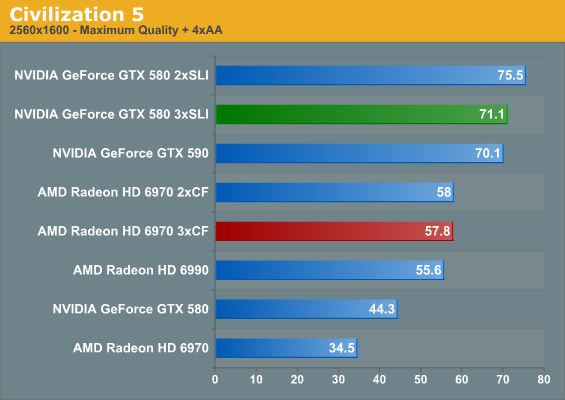
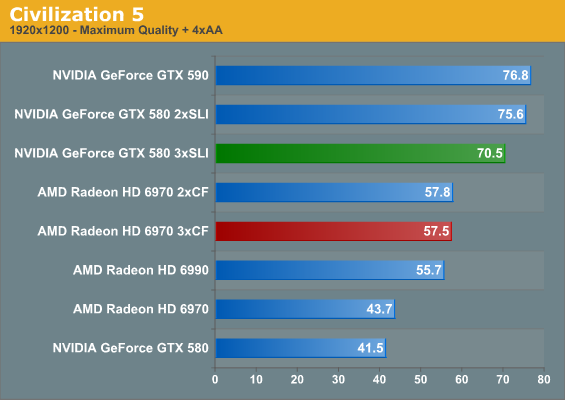
Civilization V continues to be the oddball among our benchmarks. Having started out as a title with low framerates and poor multi-GPU scaling, in recent months AMD and NVIDIA have rectified this some. As a result it’s now possible to crack 60fps at 2560 with a pair of high-end GPUs, albeit with some difficulty. In our experience Civ V is a hybrid bottlenecked game – we have every reason to believe it’s bottlenecked by the CPU at certain points, but the disparity between NVIDIA and AMD’s performance indicates there’s a big difference in how the two are settings things up under the hood.
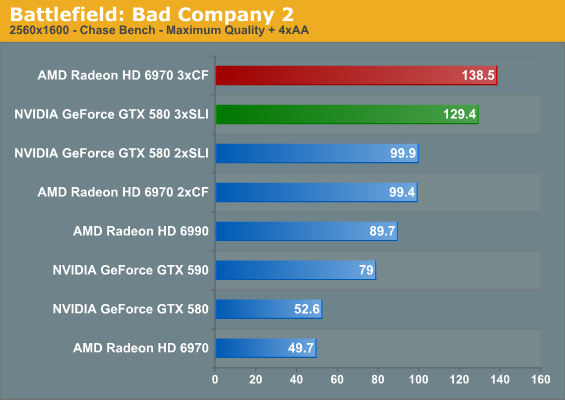
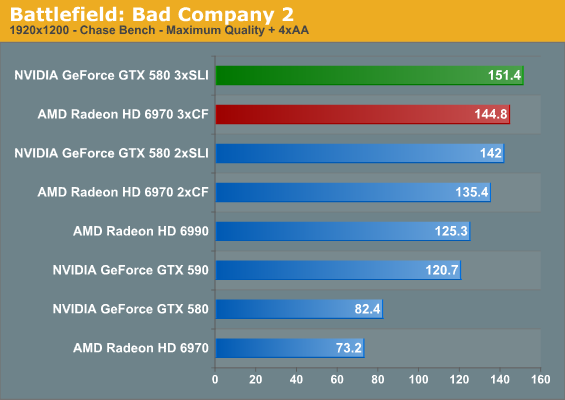
When we started using Bad Company 2 a year ago, it was actually a rather demanding benchmark; anything above 60fps at 2560 required SLI/CF. Today that’s still true, but at 52fps the GTX 580 comes close to closing that gap. On the flip side two GPUs can send scores quite a distance up, and three GPUs will push that over 120fps. Now if we could just get a 120Hz 2560 monitor…
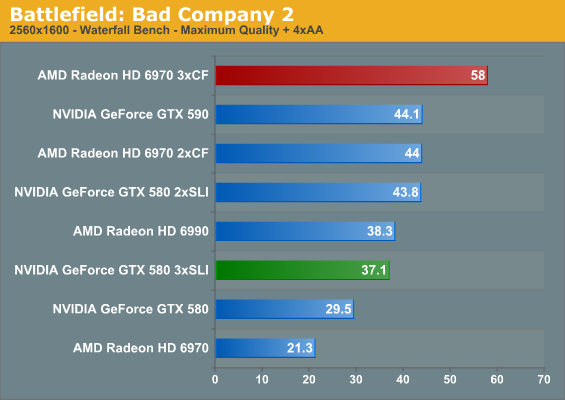
The Bad Company 2 Waterfall benchmark is our other minimum framerate benchmark, as it provides very consistent results. NVIDIA normally does well here with one GPU, but with two GPUs the gap closes to the point where NVIDIA may be CPU limited as indicated by our 580SLI/590 scores. At three GPUs AMD falls just short of a 60fps minimum, while the triple GTX 580 setup drops in performance. This would indicate uneven performance scaling for NVIDIA with three GPUs.
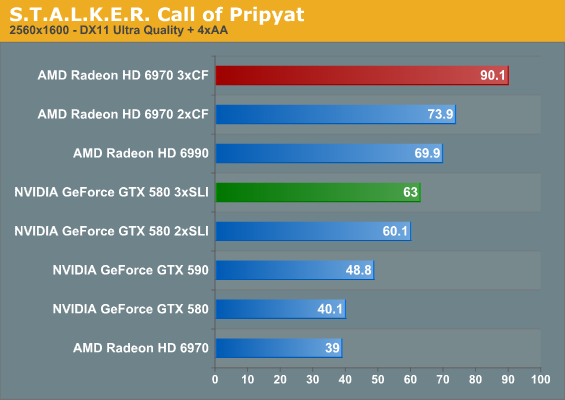
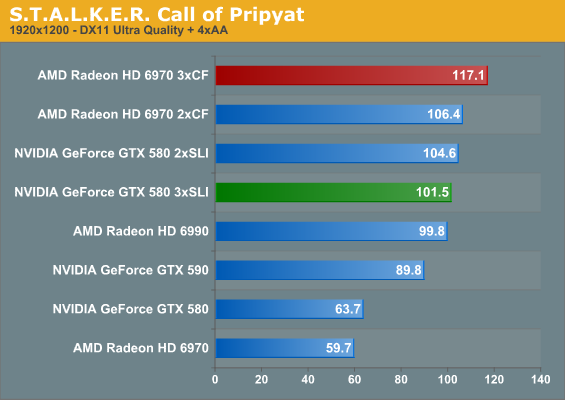
STALKER is another title that is both shader heavy and potentially VRAM-intensive. When moving from 1GB cards to 2GB cards we’ve seen the average framerate climb a respectable amount, which may be why AMD does so well here with multiple GPUs given the 512MB advantage in VRAM. With three GPUs the GTX 580 can crack 60fps, but the 6970 can clear 90fps.
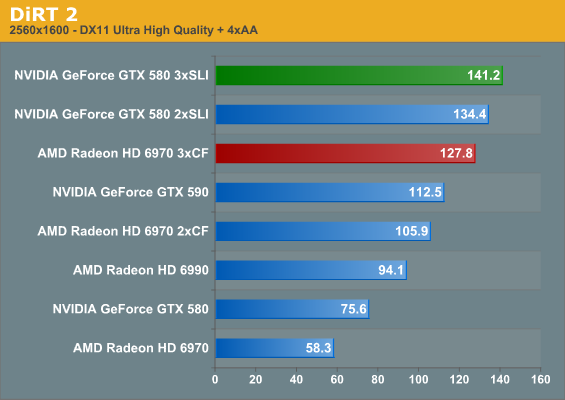
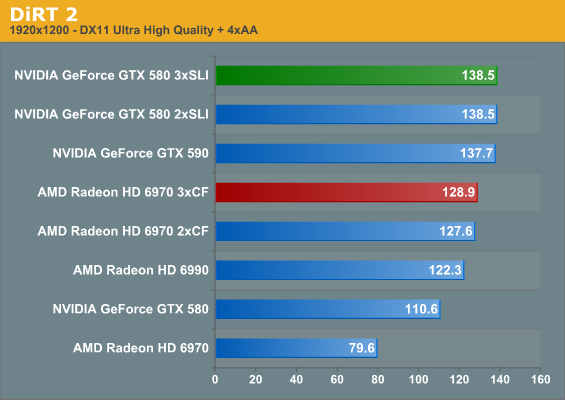
We’ve seen DiRT 2 become CPU limited with two GPUs at 1920, so it shouldn’t come as a surprise that with three GPUs a similar thing happens at 2560. Although we can never be 100% sure that we’re CPU limited versus just seeing poor scaling, the fact that our framerates top out at only a few FPS above our top 1920 scores is a solid sign of this.
| Radeon HD 6970 | GeForce GTX 580 | |||||
| GPUs | 1->2 | 2->3 | 1->3 | 1->2 | 2->3 | 1->3 |
| Civilization V | 168% | 99% | 167% | 170% | 95% | 160% |
| Battlefield: BC2 Chase | 200% | 139% | 278% | 189% | 129% | 246% |
| Battlefield: BC2 Water | 206% | 131% | 272% | 148% | 85% | 125% |
| STALKER: CoP | 189% | 121% | 231% | 149% | 104% | 157% |
| DiRT 2 | 181% | 120% | 219% | 177% | 105% | 186% |
So what does multi-GPU scaling look like in this batch of games? The numbers favor AMD at this point, particularly thanks to STALKER. Throwing out a CPU limited DIRT 2, and the average FPS for an AMD card moving from one GPU to two GPUs is 185%; NVIDIA’s gains under the same circumstances are only 169%.
For the case of two GPUs, AMD’s worst showing is Civilization V at 168%, while for NVIDIA it’s STALKER at %149. In the case of Civilization V the close gains to NVIDIA (168% vs. 170%) hides the fact that the GTX 580 already starts out at a much better framerate, so while the gains are similar the final performance is not. STALKER meanwhile presents us with an interesting case where the GTX 580 and Radeon HD 6970 start out close and end up far apart; AMD has the scaling and performance advantage thanks to NVIDIA’s limited performance gains here.
As for scaling with three GPUs, as was the case with two GPUs the results are in AMD’s favor. We still see some weak scaling at times – or none as in the case of Civilization V – but AMD’s average gain of 120% over a dual-GPU configuration isn’t too bad. NVIDIA’s average gains are basically only half AMD’s though at 110%, owing to an even larger performance loss in Civilization V, and almost no gain in STALKER. Battlefield: Bad Company 2 is the only title that NVIDIA sees significant gains in, and while the specter of CPU limits always looms overhead, I’m not sure what’s going on in STALKER for NVIDIA; perhaps we’re looking at the limits of 1.5GB of VRAM?
Looking at minimum framerates though the Battlefield: Bad Company 2, the situation is strongly in AMD’s favor for both two and three GPUs, as AMD scales practically perfectly with two GPUs and relatively well with three GPUs. I strongly believe this has more to do with the game than the technology, but at the end of the day NVIDIA’s poor triple-GPU scaling under this benchmark really puts a damper on things.










97 Comments
View All Comments
Ryan Smith - Monday, April 4, 2011 - link
There are 2 reasons for that:1) We can't immediately get another 6990. I know it seems odd that we'd have trouble getting anything, but vendors are generally uninterested in sampling cards that are reference, which is why we're so grateful to Zotac and PowerColor for the reference 580/6970.
2) We actually can't run a second 6990 with our existing testbed. The Rampage II Extreme only has x16 slots at positions 2 and 4; position 6 is x8. The spacing needs for a 6990CF setup require 2 empty slots, meaning we'd have to install it in position 6. Worse yet is that position 6 is abutted by our Antec 1200W PSU - this isn't a problem with single-GPU cards as the blowers are well clear of the PSU, but a center-mounted fan like the 6990 would get choked just as if there was another card immediately next to it.
We will be rebuilding our testbed for SNB and using a mobo with better spacing, but that's not going to happen right away. The point being that we're not ignoring the 590/6990 multiple card configurations, it's just not something we're in a position to test right now.
piroroadkill - Monday, April 4, 2011 - link
As long as it's in the works, that's alright. Seems like you have your reasons for it being the way it is.Rukur - Monday, April 4, 2011 - link
This whole technology is stupid with monitors.Why don't you stitch together 3 projectors for a seamless canvas to play a game ?
SlyNine - Monday, April 4, 2011 - link
"This whole technology is stupid with monitors." Do you suppose neural interfaces will be her soon. kick ass.Rukur - Monday, April 4, 2011 - link
Can you read more than one sentence ?monkeyshambler - Monday, April 4, 2011 - link
Interesting stuff, but for a 3 card SLI / crossfire what I'd really want to see is what the framerates are when every setting on the card is maxed.e.g. 24x AA 16x AF, high quality settings selected in the driver control panels etc.
supplement this with whats the performance on triple SLI with 3 1920*1080 monitors @ 4x AA
As lets face it if your going to spend this sort of money (and likely a watercooling rig too as theirs no way three cards are tolerable otherwise) you want to have a genuine show of why you should invest.
The current resolutions just will never stretch the cards or enable them to differentiate significantly from a standard SLI setup.
Hope we can see some of the above in a future article....
Rukur - Monday, April 4, 2011 - link
I tend to agree. How is maxing everything any worse then half inch monitor bezels all over your play area.The whole idea of eye infinity is stupid unless we all look through widows with 1 inch gaps while racing extreme cars.
How about some projectors stitched together for real people to actually try.
erple2 - Tuesday, April 5, 2011 - link
Wasn't there an analysis a while back comparing 1x, 2x, 4x, 8x and 16x AA? I thought that the conclusion to that was that there's no discernible difference between 8x and 16x AA, and the differences between 4x and 8x were only visible in careful examination of static images. Under normal play, you couldn't actually tell any difference between them.Maybe I'm just remembering wrong.
Also, I think that Ryan mentioned why they haven't yet done the triple monitor tests yet (lack of hardware).
DanNeely - Tuesday, April 5, 2011 - link
That's generally correct. Toms Hardware has run PCI restriction tests roughly once per GPU generation. The only game that ever really suffered at x4 bandwidth was MS flight simulator.PCIe bandwidth can impact some compute tasks. Einstien@home runs about 30% faster on a 460 in an 16x slot vs an 8x.
fepple - Monday, April 4, 2011 - link
With my two 5870s I have a wierd problem in crossfire. I have two screens a 24''' LCD and a 37'' LED TV. When in crossfire if I play video on the second screen it gets some odd artifacts of black(ish) horizontal lines across the bottom of the screen. Only solution i've found is to not have the cards in crossfire and plug the TV/Screen into different cards for watching stuff.Annoying, any thoughts?